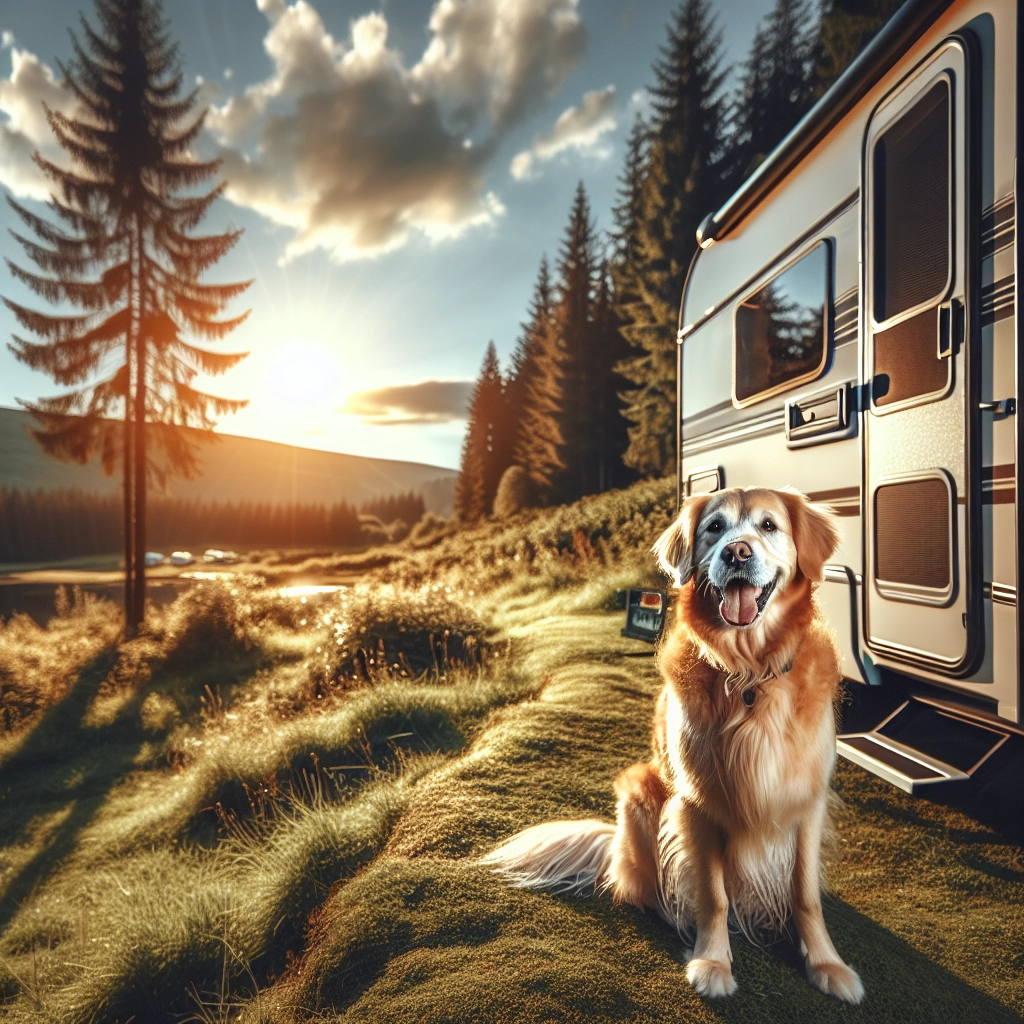Table of Contents

Article-at-a-Glance: Solar Energy Harnessing for the Nomadic Lifestyle
- Discover the freedom of full-time RV living with off-grid solar power.
- Learn how to calculate your energy needs and choose the right solar setup.
- Understand the components of a solar system: panels, batteries, and inverters.
- Maximize your solar efficiency with smart energy consumption strategies.
- Gain practical tips for maintaining and optimizing your solar power system.
Energize Your RV Adventure: Start with Solar
Imagine waking up to the gentle hum of your solar-powered RV, ready to take on the day’s adventures without a single thought about finding the next power hookup. Solar energy is not just a trend; it’s a lifestyle shift that offers you the ultimate freedom to explore without boundaries. Whether you’re parked by a serene lake or nestled in a forest, solar power keeps your home-on-wheels running smoothly. Let’s embark on this journey to energy independence together.
Why Solar Beats the Grid for RV Living
Why choose solar over traditional grid power for your RV? It’s simple. Solar power grants you autonomy. You’re no longer tethered to designated campgrounds for electricity. With solar, you can park anywhere permissible, known as ‘boondocking,’ and still enjoy all the comforts of home. Plus, solar energy is clean, quiet, and, once set up, an incredibly cost-effective power source. Say goodbye to noisy generators and fluctuating power bills.
- Freedom to camp anywhere with sun exposure.
- Quiet and clean energy source, unlike gas generators.
- Long-term cost savings after initial investment.
- Less environmental impact, promoting sustainable living.
- Increased self-sufficiency and peace of mind.
The Essentials of an Off-Grid Solar System
An off-grid solar system for your RV is more than just slapping some panels on the roof. It’s a symphony of components working in harmony to convert sunlight into usable power. The main players are solar panels, a charge controller, batteries, and an inverter. Each serves a critical role: panels harvest the sun’s energy, the charge controller manages the charge to the batteries, batteries store this power, and the inverter converts it to the right voltage for your RV’s appliances.
- Solar Panels: The face of your solar system, capturing sunlight.
- Charge Controller: The gatekeeper, ensuring batteries charge correctly and safely.
- Batteries: The storage units for your collected solar energy.
- Inverter: The translator, converting stored energy into usable power for your appliances.
Sizing Up Your Solar Needs
Getting the right solar setup isn’t a one-size-fits-all scenario. It’s about understanding your specific energy requirements. How much power do you need daily? What appliances are essential for your comfort and lifestyle? These are the questions that will guide you to a solar system that won’t leave you in the dark or with excess, unused energy.
Determining Your Energy Consumption
Before diving into solar, you need to know your energy habits. Start by listing all your electronic devices and appliances. How many hours do you use them each day? From here, you can calculate your daily power consumption. This step is crucial because it helps you size your system to meet your needs without overspending on unnecessary capacity.
For example, if your LED lights use 30 watts and run for 5 hours a day, that’s 150 watt-hours per day just for lighting. Repeat this process for all your devices to get a daily total.
- Make a list of all electrical devices and appliances in your RV.
- Record the wattage of each item and how long you use it daily.
- Add up the daily usage to get a total in watt-hours.
- Consider seasonal changes in sunlight and energy use.
- Remember to account for occasional high-power items or extra guests.
Calculating Solar Panel Output for Your RV
Now that you know your energy needs, let’s talk about solar panel output. Panels are rated by the wattage they can produce in an hour of direct sunlight. To figure out how many panels you’ll need, divide your daily watt-hour requirement by the number of peak sunlight hours in your area. This gives you the total watts your panels need to produce. Remember, it’s better to have a little extra than not enough, as conditions aren’t always ideal.
For instance, if you need 1500 watt-hours per day and you get 5 peak sunlight hours, you’ll need 300 watts of solar panels.
- Check the wattage rating on potential solar panels.
- Estimate the average peak sunlight hours for areas you’ll visit.
- Divide your daily energy requirement by peak sunlight hours for total wattage needed.
- Consider efficiency losses and opt for a bit more wattage than the bare minimum.
Choosing Your Solar Gear
Choosing the right solar gear is essential for a successful off-grid experience. It’s not just about picking the highest wattage or the cheapest option; it’s about finding the right balance for your RV’s needs. We’ll cover the key components you need to consider: solar panels, charge controllers, batteries, and inverters. Each plays a vital role in your energy system, and understanding them is the first step to a reliable setup.
Picking the Right Solar Panels
Solar panels are the workhorses of your system, soaking up the sun’s rays and turning them into electricity. When selecting panels, consider their efficiency, durability, and size. Monocrystalline panels are more efficient but often come with a higher price tag. Polycrystalline panels are more affordable but less efficient. Think about your RV’s roof space and your travel habits. Flexible panels might be a good fit if you need a low-profile setup.
- Monocrystalline panels for efficiency in smaller spaces.
- Polycrystalline panels for a more budget-friendly option.
- Flexible panels can be ideal for RVs with limited or curved roof space.
- Consider the weight and mounting system of the panels for your RV’s roof.
Charge Controllers: The Heart of Solar Regulation
Charge controllers are the guardians of your solar system. They regulate the voltage and current coming from your panels to your batteries, ensuring they charge safely and efficiently. There are two main types: PWM (Pulse Width Modulation) and MPPT (Maximum Power Point Tracking). MPPT controllers are more efficient and better for larger systems, while PWM controllers are more cost-effective for smaller setups.
- PWM controllers are ideal for smaller systems and tighter budgets.
- MPPT controllers maximize efficiency for larger solar arrays.
- Ensure the controller can handle the voltage and current of your panels.
- Look for controllers with additional features like load control and system monitoring.
Batteries: Storing Your Sunlight
Batteries are where you store the power for use when the sun isn’t shining. The two main types of batteries used in RV solar setups are lead-acid and lithium. Lead-acid batteries are more affordable but require regular maintenance and have a shorter lifespan. Lithium batteries are pricier upfront but last longer, require no maintenance, and have a higher energy density, meaning they store more power in a smaller space.
- Lead-acid batteries for a cost-effective solution with proper maintenance.
- Lithium batteries for a long-lasting, maintenance-free option.
- Consider the battery capacity (Ah) needed to meet your energy requirements.
- Remember that batteries should not be discharged completely to prolong their life.
Finding the Perfect Solar Inverter
The inverter is your solar system’s translator, converting DC power from your panels and batteries into AC power for your RV’s outlets. Inverters come in different sizes and types, with pure sine wave inverters providing power most similar to household current. This is important for sensitive electronics like laptops. Make sure the inverter’s wattage rating matches or exceeds your highest power draw.
- Pure sine wave inverters for clean, reliable power.
- Modified sine wave inverters as a more affordable but less reliable option.
- Choose an inverter with a wattage rating that meets or exceeds your peak power usage.
- Consider an inverter with built-in USB ports for charging small devices directly.

Maximizing Solar Efficiency
To get the most out of your solar panels, it’s not just about how much energy you can produce—it’s also about how much you can save. Maximizing solar efficiency means making every watt count. This involves smart energy use and ensuring your system is running at peak performance. After all, the less energy you use, the less you have to generate.
Strategies to Reduce Energy Consumption
Reducing your energy consumption doesn’t mean sacrificing comfort. It means being smart about the energy you use. Start by switching to LED lighting, which uses a fraction of the power of traditional bulbs. Use natural ventilation instead of air conditioning when possible. Insulate your RV to maintain temperature and reduce heating and cooling needs. And remember, turning off appliances when they’re not in use goes a long way.
- Switch to LED lights for lower power usage.
- Utilize natural ventilation to minimize AC use.
- Insulate your RV to keep cool in summer and warm in winter.
- Unplug chargers and turn off appliances when not in use.
- Use energy-efficient appliances designed for RV use.
Positioning Panels: The Angle for Optimal Sun Exposure
Getting the angle right on your solar panels can significantly increase their efficiency. The ideal angle is equal to your latitude, tilted towards the sun. This maximizes the amount of sunlight hitting the panels throughout the day. If adjusting the angle regularly isn’t practical, set your panels at an angle that captures the most sun during the peak solar hours—usually around midday.
- Adjust panel angle to match your latitude for optimal sun exposure.
- Consider seasonal changes; the sun is higher in summer and lower in winter.
- If adjustable mounts aren’t an option, aim for the best compromise angle.
- Ensure panels are free from shade and debris for maximum efficiency.
Solar System Installation and Upkeep
Proper installation and maintenance of your solar system are key to its longevity and efficiency. A well-installed system will provide reliable power for years, but it does require some upkeep. By following a few steps and regular checks, you can ensure your solar investment continues to pay off, keeping you powered up and ready for adventure.
DIY Installation: Steps and Tips
Installing a solar system on your RV can be a rewarding DIY project. Start by mapping out where each component will go, ensuring the panels get maximum sunlight and the batteries are kept in a cool, ventilated space. Securely mount your panels and connect them to the charge controller, which then connects to the batteries and inverter. Always follow the manufacturer’s instructions and use proper safety equipment.
- Plan the layout of your system components carefully.
- Mount panels securely to withstand travel vibrations.
- Use proper gauge wiring to prevent energy loss and overheating.
- Follow a detailed guide or consult with a professional if unsure.
Regular Maintenance to Prolong System Life
Maintenance is the key to a long-lasting solar system. Keep your panels clean from dust, dirt, and snow, which can block sunlight. Check connections for corrosion and ensure they’re tight. Regularly inspect your batteries for signs of wear and ensure they’re charged properly. By taking care of your system, you can prevent issues before they start and enjoy uninterrupted power.
- Clean solar panels regularly to remove obstructions.
- Inspect wiring and connections for signs of wear or corrosion.
- Check battery water levels if using lead-acid batteries and top up as needed.
- Ensure batteries are not overcharged or deeply discharged.
- Keep an eye on your system’s performance to catch potential problems early.
The Art of Boondocking with Solar Power
Boondocking, or dry camping, is the practice of parking your RV in a place without hookups and relying on your own resources. It’s the ultimate test of your solar power setup and your resourcefulness. Mastering the art of boondocking with solar power means you can live comfortably in the most remote and scenic locations. It’s about being self-sufficient, conserving energy, and enjoying the serenity of nature without leaving a trace.
Resource Management and Conservation
Effective resource management is crucial when you’re off the grid. It’s all about using what you have wisely. Start by monitoring your energy consumption closely. Use appliances during peak solar hours to take advantage of the energy as it’s generated. Conserve water by taking shorter showers and using water-saving fixtures. Manage waste by recycling and composting. Every bit of conservation helps extend the time you can spend boondocking.
- Monitor energy usage with a reliable system monitor.
- Use high-energy appliances like washing machines during peak sunlight.
- Install water-saving fixtures to reduce water consumption.
- Compost organic waste to minimize trash output.
- Plan meals to use less water and energy for cooking and cleaning.
Handling Extended Stays and Inclement Weather
When you’re boondocking for extended periods, or when the weather turns against you, your solar setup’s resilience is put to the test. Always have a backup plan for energy, such as a generator, especially if you expect several days of cloud cover. Store extra water and non-perishable food in case you need to hunker down. And remember, the right attitude goes a long way. Embrace the challenge as part of the adventure.
- Keep a backup generator for days with insufficient sunlight.
- Insulate your RV to maintain comfortable temperatures during extreme weather.
- Store additional supplies like water, food, and warm clothing.
- Stay informed about weather conditions and be prepared to adjust your plans.

Your Solar-Powered Home on Wheels
Your RV is more than just a vehicle; it’s your home. And with solar power, it’s a self-sufficient home that can take you anywhere. Imagine the freedom of living where you want, how you want, all while being kind to the environment. Your solar-powered RV is a statement of independence and a commitment to a sustainable lifestyle. It’s about making memories without the worry of finding the next power source.
Real-Life Benefits of Solar for Full-Time RVers
For those who’ve made the leap to full-time RV living with solar power, the benefits are tangible. There’s the financial savings from not paying for hookups or generator fuel. The peace of mind that comes from knowing you’re powered by the sun. The ability to stay in beautiful, remote locations for longer periods. And let’s not forget the positive environmental impact of reducing your carbon footprint.
- Significant savings on campground fees and generator costs.
- Freedom to explore remote locations without sacrificing comfort.
- Reduced noise and air pollution compared to generator use.
- Less dependency on fossil fuels, leading to a smaller carbon footprint.
- Increased RV resale value with a quality solar setup.
Transitioning to a Solar-Powered RV Lifestyle
Moving to a solar-powered RV lifestyle is a journey, not a sprint. Start by researching and understanding your energy needs. Gradually replace energy-hungry appliances with more efficient ones. Learn from the RV community—there are many experienced solar RVers happy to share their knowledge. And finally, embrace the learning curve. Every mistake is an opportunity to improve your system and your boondocking skills.
- Assess and understand your energy needs before investing in solar.
- Upgrade to energy-efficient appliances to reduce your overall power consumption.
- Connect with other solar RVers for tips and advice.
- Be patient and allow yourself to learn from experience.
- Consider renting a solar-equipped RV to try before you commit.
Frequently Asked Questions
Can I Install Solar Panels on Any Type of RV?
Yes, you can install solar panels on virtually any RV, from massive Class As to cozy pop-up campers. The key is to tailor the system to fit your RV’s roof space and your power needs. Some RVs may require creative solutions, like using portable panels or custom mounts, but there’s almost always a way to harness the power of the sun for your rig.
– Assess your RV’s roof space and structure for panel placement.
– Consider portable solar panels for RVs with limited roof space.
– Custom mounting solutions can adapt to various RV designs.
– Consult with a solar expert or experienced installer for unique setups.
How Many Solar Panels Do I Need for Full-Time Boondocking?
The number of solar panels you need depends on your daily power consumption and the amount of sunlight you receive. As a rule of thumb, a typical full-time boondocker might need anywhere from 300 to 800 watts of solar panels. However, this can vary widely based on your lifestyle and the efficiency of your appliances.
– Calculate your daily power usage to estimate your needs.
– Factor in the average peak sunlight hours in areas you plan to visit.
– Remember that more efficient appliances mean fewer panels needed.
– Always round up your estimates to account for less-than-ideal conditions.
What’s the Lifespan of an RV Solar Power Setup?
A well-maintained RV solar power setup can last a surprisingly long time. Solar panels themselves often come with a warranty of 25 years or more, and they can continue to work beyond that, albeit at reduced efficiency. Batteries and other components may need to be replaced more frequently, with lithium batteries lasting up to 10 years and lead-acid around 5 years.
– Solar panels can last 25 years or more with proper care.
– Lithium batteries have a lifespan of up to 10 years.
– Regular maintenance can extend the life of all components.
– Quality components may offer longer lifespans and better performance.
Can I Run My Air Conditioner on Solar Power?
Running an air conditioner on solar power is possible, but it requires a substantial solar setup and battery bank. Air conditioners are power-hungry appliances, so you’ll need to calculate your AC’s power draw and have enough battery capacity to handle it. It’s also wise to use the AC sparingly and consider alternatives like fans or natural ventilation when possible.
– Determine the power consumption of your air conditioner.
– Ensure you have enough battery capacity to run the AC.
– Use energy-efficient AC units and run them during peak solar hours.
– Consider alternative cooling methods to reduce reliance on the AC.
How Can I Monitor My Solar System’s Performance?
Monitoring your solar system’s performance is crucial for ensuring it runs efficiently. Many charge controllers come with built-in monitors, or you can install a separate monitoring system. These devices provide real-time data on power production, consumption, and battery health, allowing you to make adjustments as needed to optimize your system’s performance.
– Use a charge controller with an integrated monitor for convenience.
– Consider a separate monitoring system for detailed performance data.
– Regularly check your system’s output to ensure it meets your needs.
– Use the data to adjust your energy usage and improve efficiency.
As you embrace the solar-powered RV lifestyle, remember that you’re joining a community of adventurers who value freedom, sustainability, and the joy of exploration. With the sun as your power source, the horizon is truly your limit. Safe travels, and may your solar journey be as bright as the skies above!
- Boondocking RVs: Flexible Solar Solutions – 3 March 2024
- Renewable Energy Tips for Full-Time Boondocking RVers – 2 March 2024
- Boondocking Solar Power Systems: Sizing Options & Solutions for Motorhomes – 1 March 2024
